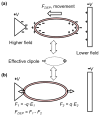Erythrocyte Membrane Failure by Electromechanical Stress
- PMID: 29682337
- PMCID: PMC5909407
- DOI: 10.3390/app8020174
Erythrocyte Membrane Failure by Electromechanical Stress
Abstract
We envision that electrodeformation of biological cells through dielectrophoresis as a new technique to elucidate the mechanistic details underlying membrane failure by electrical and mechanical stresses. Here we demonstrate the full control of cellular uniaxial deformation and tensile recovery in biological cells via amplitude-modified electric field at radio frequency by an interdigitated electrode array in microfluidics. Transient creep and cyclic experiments were performed on individually tracked human erythrocytes. Observations of the viscoelastic-to-viscoplastic deformation behavior and the localized plastic deformations in erythrocyte membranes suggest that electromechanical stress results in irreversible membrane failure. Examples of membrane failure can be separated into different groups according to the loading scenarios: mechanical stiffening, physical damage, morphological transformation from discocyte to echinocyte, and whole cell lysis. These results show that this technique can be potentially utilized to explore membrane failure in erythrocytes affected by other pathophysiological processes.
Keywords: cell biomechanics; cell lysis; dielectrophoresis; erythrocyte; membrane failure; microfluidics.
Conflict of interest statement
Conflicts of Interest: The authors declare no conflict of interest. The founding sponsors had no role in the design of the study; in the collection, analyses, or interpretation of data; in the writing of the manuscript; or in the decision to publish the results.
Figures







Similar articles
-
Dynamic fatigue measurement of human erythrocytes using dielectrophoresis.Acta Biomater. 2017 Jul 15;57:352-362. doi: 10.1016/j.actbio.2017.05.037. Epub 2017 May 17. Acta Biomater. 2017. PMID: 28526627
-
Amplitude-Modulated Electrodeformation to Evaluate Mechanical Fatigue of Biological Cells.J Vis Exp. 2023 Oct 13;(200). doi: 10.3791/65897. J Vis Exp. 2023. PMID: 37902362
-
Modeling erythrocyte electrodeformation in response to amplitude modulated electric waveforms.Sci Rep. 2018 Jul 5;8(1):10224. doi: 10.1038/s41598-018-28503-w. Sci Rep. 2018. PMID: 29976935 Free PMC article.
-
Electric field-induced effects on neuronal cell biology accompanying dielectrophoretic trapping.Adv Anat Embryol Cell Biol. 2003;173:III-IX, 1-77. doi: 10.1007/978-3-642-55469-8. Adv Anat Embryol Cell Biol. 2003. PMID: 12901336 Review.
-
Electromechanical and physicochemical properties of connective tissue.Crit Rev Biomed Eng. 1983;9(2):133-99. Crit Rev Biomed Eng. 1983. PMID: 6342940 Review.
Cited by
-
Unintended Changes of Ion-Selective Membranes Composition-Origin and Effect on Analytical Performance.Membranes (Basel). 2020 Sep 28;10(10):266. doi: 10.3390/membranes10100266. Membranes (Basel). 2020. PMID: 32998393 Free PMC article. Review.
-
Advances in Microfluidics for Single Red Blood Cell Analysis.Biosensors (Basel). 2023 Jan 9;13(1):117. doi: 10.3390/bios13010117. Biosensors (Basel). 2023. PMID: 36671952 Free PMC article. Review.
-
A Novel Methodology to Obtain the Mechanical Properties of Membranes by Means of Dynamic Tests.Membranes (Basel). 2022 Mar 2;12(3):288. doi: 10.3390/membranes12030288. Membranes (Basel). 2022. PMID: 35323765 Free PMC article.
-
Microscale nonlinear electrokinetics for the analysis of cellular materials in clinical applications: a review.Mikrochim Acta. 2021 Mar 2;188(3):104. doi: 10.1007/s00604-021-04748-7. Mikrochim Acta. 2021. PMID: 33651196 Review.
-
Mechanical Stimulation of Red Blood Cells Aging: Focusing on the Microfluidics Application.Micromachines (Basel). 2025 Feb 25;16(3):259. doi: 10.3390/mi16030259. Micromachines (Basel). 2025. PMID: 40141870 Free PMC article. Review.
References
-
- Reid HL, Dormandy JA, Barnes AJ, Lock PJ, Dormandy TL. Impaired Red-Cell Deformability in Peripheral Vascular-Disease. Lancet. 1976;307:666–668. - PubMed
-
- Suresh S. Mechanical response of human red blood cells in health and disease: Some structure-property-function relationships. J Mater Res. 2006;21:1871–1877.
-
- Black KL, Jones RD. The discocyte-echinocyte transformation as an index of human red cell trauma. Ohio J Sci. 1976;76:225–230.
-
- Dondorp AM, Kager PA, Vreeken J, White NJ. Abnormal blood flow and red blood cell deformability in severe malaria. Parasitol Today. 2000;16:228–232. - PubMed
Grants and funding
LinkOut - more resources
Full Text Sources
Other Literature Sources
